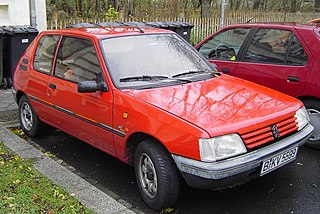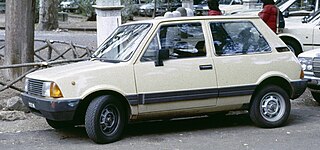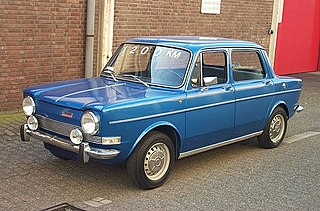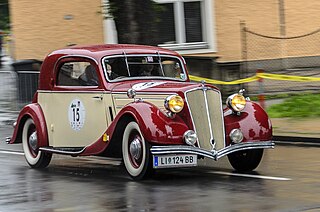
The Peugeot 205 is a supermini (B-segment) car produced by the French manufacturer Peugeot from 1983 to 1999.

The Citroën Visa is a five-door, front-engine, front wheel drive supermini manufactured and marketed by Citroën from 1978 to 1988 in gasoline and diesel variants. 1,254,390 examples were ultimately manufactured over a single generation, with a single facelift (1981). China has also assembled the car as the Liuzhou Wuling LZW 7100 minicar. Production started in 1991 and finished in 1994.

The Peugeot 504 is a mid-size, front-engine, rear-wheel-drive automobile manufactured and marketed by Peugeot from 1968 to 1983 over a single generation, primarily in four-door sedan and wagon configurations – but also as twin two-door coupé and cabriolet configurations as well as pickup truck variants.

The Fiat Uno is a front-engine, front-drive, four-passenger supermini manufactured and marketed by Fiat. Launched in 1983, the Uno was produced over a single generation in three and five-door hatchback body styles until 1995 in Europe — and until 1 January 2014, in Brazil. Designed by Giorgetto Giugiaro of Italdesign, the Uno strongly recalled the high-roof, up-right packaging of Giugiaro's 1978 Lancia Megagamma concept, in a smaller configuration.

The Peugeot 505 is a large family car produced by the French manufacturer Peugeot from 1979 to 1992 in Sochaux, France. It was also manufactured in various other countries including Argentina, China, Thailand, Indonesia and Nigeria. The 505 was Peugeot's last rear-wheel drive car.

The Mazda Luce is an executive car that was produced by Mazda in Japan from 1966 until 1991. It was widely exported as the Mazda 929 from 1973 to 1991 as Mazda's largest sedan. Later generations were installed with luxury items and interiors as the Luce became the flagship offering. The Luce was replaced by the Sentia in 1991 which was also exported under the 929 nameplate.

The Peugeot 403 is a mid-size car manufactured and marketed by Peugeot between May 1955 and October 1966. A total of 1,214,121 of all types, including commercial models, were produced, making it the first Peugeot to exceed one million in sales.

The Fiat 131 is a family sedan manufactured and marketed by Fiat from 1974 to 1984 after its debut at the 1974 Turin Motor Show. Available as a two-door and four-door saloon and 5-door estate across a single generation, the 131 succeeded the Fiat 124.

The Innocenti Mini is an automobile introduced by Innocenti in 1974. The vehicle was a rebodied, three-door hatchback version of the Mini, styled by Bertone. A five-door prototype was developed around 1980, but was never put into production. After having been sold to De Tomaso in 1976, the Innocenti Mini ended up being powered by Daihatsu-sourced three-cylinder engines and continued in production in incrementally updated forms until 1993.

The Panhard Dyna Z is a lightweight motor car produced by Panhard of France from 1954 to 1959. It was first presented to the press at a Paris restaurant named Les Ambassadeurs on 17 June 1953 and entered production the following year. In 1959, it was replaced by the Panhard PL 17.

The Fiat 850 is a small rear-engine, rear-wheel-drive car manufactured and marketed by Italian car manufacturer Fiat from 1964 to 1973.

The Simca 1000 is a small, rear-engined, four-door saloon which was manufactured by the French automaker Simca from 1961 to 1978.

The Simca Aronde is an automobile which was manufactured by the French automaker Simca from 1951 to 1964. It was Simca's first original design, as well as the company's first unibody car. "Aronde" means "swallow" in Old French and it was chosen as the name for the model because Simca's logo at that time was a stylized swallow.
Buchet was a French motorcycle and automobile manufacturer between 1911 and 1930.

The Peugeot 402 is a large family car produced in Sochaux, France from 1935 to 1942 by Peugeot. It was unveiled at the Paris Motor Show in 1935, replacing the Peugeot 401.

The Panhard et Levassor Dynamic is a large car introduced by the French auto-maker Panhard et Levassor as a replacement for the company’s CS model at the Paris Motor Show in October 1936.

The Opel Rekord D series is an executive car that replaced the Rekord C on Opel's Rüsselsheim production lines during the closing weeks of 1971 and launched on the West German market at the start of 1972. It shared its wheelbase and inherited most of its engines from its predecessor, but the bodies were completely new. Also new, announced in September 1972, was the option of a diesel powered Opel Rekord. Early advertising and press material called the new car the "Opel Rekord II" but in due course, the "Rekord II" appellation was quietly dropped and the Rekord D was replaced at the end of the 1977 summer holiday shut down by the Opel Rekord E.

The Salmson S4 is a mid-size executive-level car introduced as the Salmson S4 C by Société des Moteurs Salmson in Autumn 1932. It was the manufacturer's principal and often sole model for the next twenty years.
Octo was a French automobile manufactured at Courbevoie by Louis Vienne between 1921 and 1928.

The Ligier JS4 is a four-wheeled, two-seater microcar manufactured from 1980 to 1983 by Ligier, the street vehicle branch of French Formula One manufacturer Equipe Ligier. It marked a change in Ligier's priorities as they had recently ended manufacture of the Ligier JS2 sports car. It is a "Voiture sans permis", a light vehicle which did not require a driver's license and was thus popular with the elderly, the young, or with those who had lost their driving privileges. The JS4 was first presented on 25 July 1980.




















